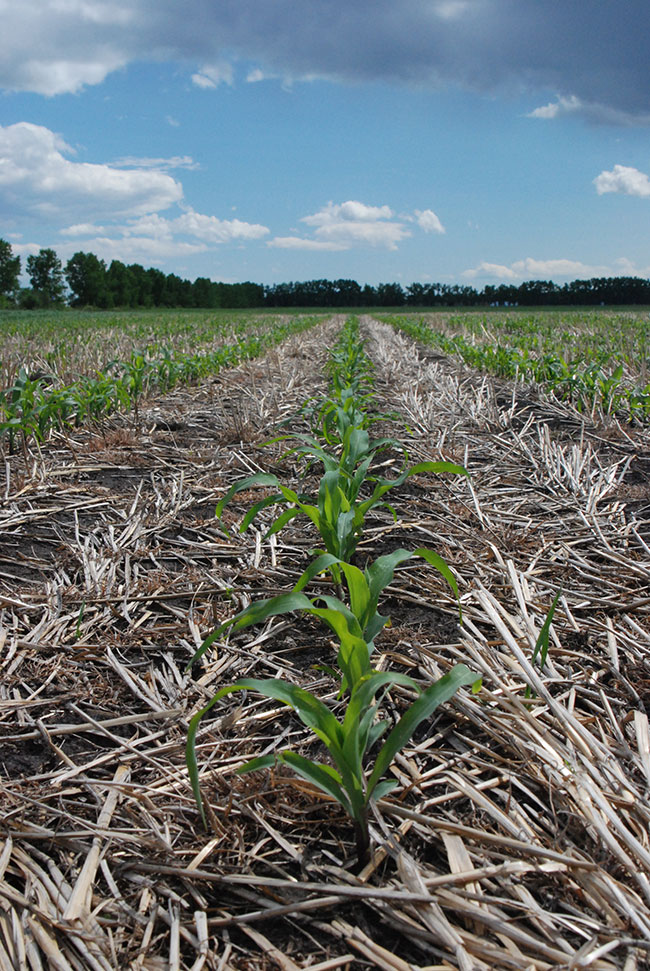
Features
Fertility and Nutrients
A not-so-basic test: plant tissue testing
Plant tissue testing can be useful as a diagnostic tool, with some caveats.
December 15, 2019 By Bruce Barker
 Tissue testing can be a useful diagnostic tool in corn and potatoes.
Photo by Bruce Barker.
Tissue testing can be a useful diagnostic tool in corn and potatoes.
Photo by Bruce Barker. On the surface, plant tissue testing looks like a reliable method of assessing fertility programs: compare nutrient levels in the tissue with a known range of nutrient concentrations for that variety to see if the fertility program is adequate. If only it was that easy.
“Plant tissue testing is really valuable if you have the proper criteria to assess nutrient levels in the tissue. Back in the day, criteria had been established for many crops, but with all the new canola, wheat and hybrid crops, you can’t apply the older criteria when making recommendations for some of today’s crops,” says Rigas Karamanos, senior agronomist with Koch Fertilizer Canada in Calgary.
Karamanos says in order for tissue testing to provide reliable guidance, a research database needs to be set up for each crop that calibrates the tissue nutrient level with yield responses to applied nutrients. And because varieties differ within crop type in their nutrient levels, each crop variety needs calibrating to ensure reliability. As a result, high-value crops are the ones most often calibrated.
“Because [potatoes] are a high-value crop, calibration is kept up on every cultivar. Most of the corn hybrids are well calibrated as well,” Karamanos says. “Sample. Analyze. Calibrate. Interpret. You have to ask the labs what criteria they are using to get any value out of the tissue test.”
As an example of the variability of nutrients between varieties, Karamanos cites research on 12 different edible beans and their zinc concentration in Morden, Man. Zinc tissue content ranged from a low of 18 parts per million (ppm) to a high of 29 ppm on the control plots without added zinc, and a low of 23.5 ppm to a high of 34.5 ppm on plots receiving zinc fertilization.
Sampling challenges
Stage of growth, the plant part and number sampled, and time of sampling can all affect nutrient concentrations. For example, nitrate accumulates at night, so tissue samples should not be taken in the early morning or late afternoon.
Stress can also impact nutrient concentrations in tissue. If plants are under stress caused by factors other than nutrient deficiency or toxicity, the tissue can accumulate higher than normal nutrient levels. A reliable tissue analyses can only be achieved after the stress has alleviated.
A reliable tissue analyses can only be achieved after the stress has alleviated.
Plant tissue can also be contaminated with dust or soil, and this contamination can result in inaccurate results. Avoid contact with fertilizers, salts, grease, and cigarette ashes.
Each laboratory has its own sampling protocols. Growers and agronomists should consult with their laboratory for proper sampling techniques.
Interpreting the results
Plant tissue testing can be useful in evaluating fertilizer management programs, diagnosing nutrient-related crop production problems and identifying nutrient levels in crops that may limit yield. Plant analysis is very useful in assessing boron, iron and molybdenum, since these nutrients do not have reliable soil tests. It can also be used to evaluate phosphorus, potassium, magnesium and manganese fertility, but is not always reliable for nitrogen and zinc.
Plant analysis is very useful in assessing boron, iron and molybdenum, since these nutrients do not have reliable soil tests.
If used as a diagnostic tool, remedial fertilizer applications can be applied in-season to help overcome the deficiency. There is a small window of application for nitrogen and sulphur fertilizer of about four to six weeks after seeding. Phosphorus and potassium do not usually respond to in-season application, so tissue sampling would be used for fertility planning the following year.
Micronutrients have a wide window of in-season application, and because they are applied at relatively low rates and are also important during the reproductive stages of crops, (i.e. seed formation), tissue testing can help provide the information for rescue applications when a deficiency is analyzed.
“Tissue testing is a great tool for high value crops where the database is kept up to date. It can be useful in potatoes and corn where in-season fertilizer application can improve yield, but for the rest of the crops, it is usually too late to do much,” Karamanos says. He recommends talking to the seed supplier and sampling laboratories to determine if a particular crop or variety has been calibrated in your area.